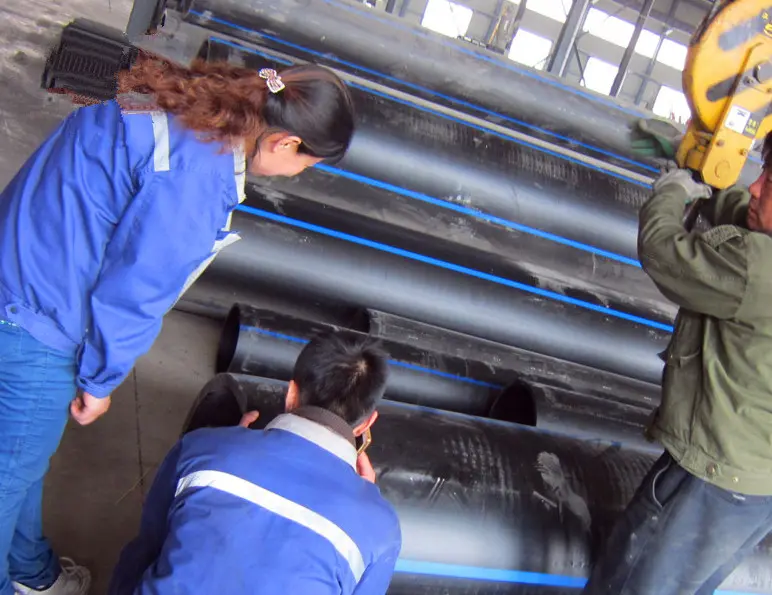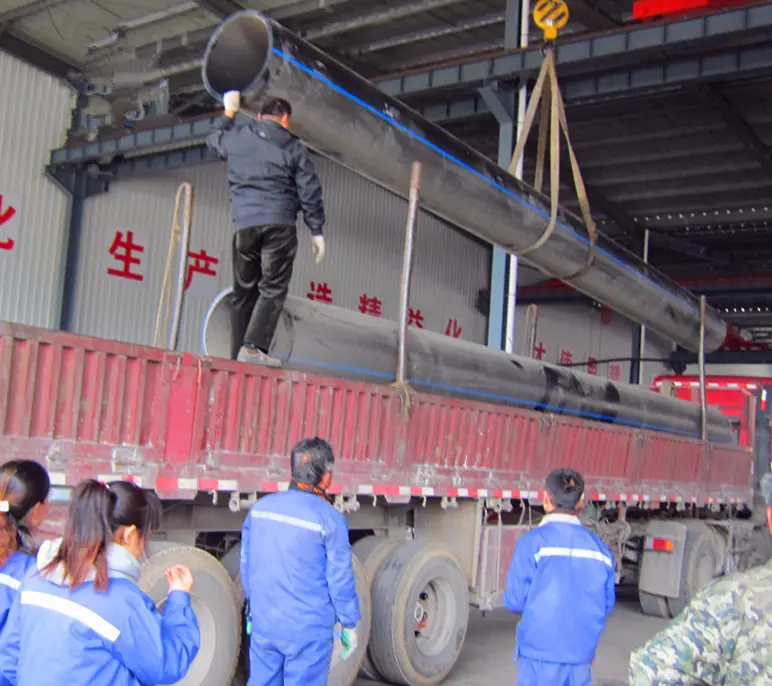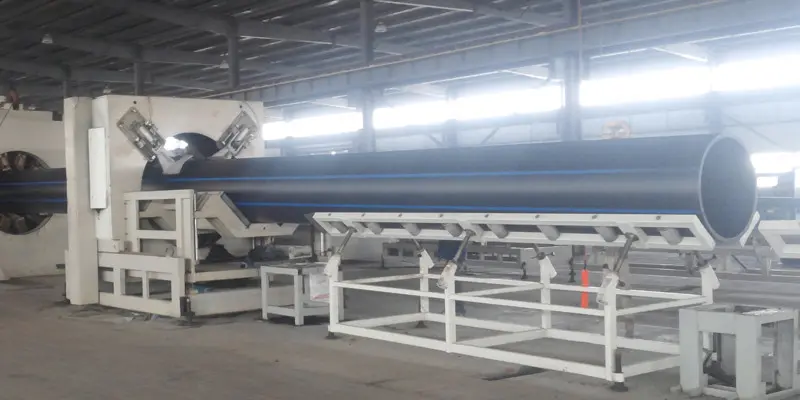With the intensification of the global energy crisis and the improvement of environmental protection awareness, geothermal energy, as a clean and renewable energy source, has been increasingly valued by governments and enterprises. Geothermal system is a technology that uses underground thermal resources to provide hot water, heating and cooling for buildings. In geothermal systems, pipes are key components that connect various equipment and buildings, and their quality directly affects the operating efficiency and safety of geothermal systems.
1. What is HDPE pipe?
HDPE (high-density polyethylene) pipes are widely used in geothermal systems, mainly because of their excellent physical and chemical properties and economic benefits. The following are the main application characteristics of HDPE pipes in geothermal systems:
Corrosion resistance: HDPE pipes have strong corrosion resistance to a variety of chemicals and environmental conditions, which makes them effectively resist the erosion of high temperature and corrosive fluids in geothermal systems.
Flexibility: HDPE pipes have good flexibility and impact resistance, can adapt to geological changes and environmental stress, and reduce damage to pipes caused by foundation settlement or deformation during the operation of geothermal systems.
Thermal stability: Although HDPE pipes have a low melting point, proper design and construction techniques can ensure that they can withstand higher temperatures and pressures in geothermal systems. They can be used for a long time in high temperature environments above 70°C, which is suitable for the temperature requirements of geothermal systems.
539677.webp)
Easy installation: HDPE pipes have various connection methods, such as hot melt welding, socket welding, etc., which makes the installation process quick and reliable, reducing construction time and cost.
Low thermal conductivity: The low thermal conductivity of HDPE materials helps to reduce heat loss in geothermal systems and improve the energy efficiency of the system.
Durability: HDPE pipes have a long service life and can meet the requirements of long-term operation of geothermal systems, thereby reducing the frequency of maintenance and replacement.
Pressure resistance: HDPE pipes have high compressive strength and can withstand greater ground pressure, ensuring the safe and stable operation of geothermal systems.
Environmental performance: HDPE pipes are produced with environmentally friendly raw materials, are non-toxic, odorless, pollution-free, recyclable, and meet the green environmental protection requirements of geothermal systems.
Anti-aging: HDPE pipes have good anti-aging properties and can be used outdoors for a long time without aging and deformation.
In geothermal systems, HDPE pipes are often used for geothermal return pipes, geothermal collection pipes, and geothermal distribution pipes. These characteristics make HDPE pipes an economical and practical choice in geothermal systems.

2. Installation process of HDPE pipes
The installation process of HDPE (high-density polyethylene) pipes in geothermal systems includes several key steps to ensure the effectiveness and long-term stability of the system. The following is a typical installation process:
1)Planning and design
·Demand analysis: Determine the specifications, quantity, and layout of HDPE pipes based on the design requirements of the geothermal system. Including the diameter, length, and heat energy transmission requirements of the pipes.
·Site survey: Conduct geological surveys on the installation site to understand the soil type, groundwater level, and possible obstacles to develop a suitable installation plan.
·Design drawings: Draw detailed pipeline installation drawings and construction plans based on the survey results and demand analysis.

2)Material preparation
·Pipeline procurement: Select HDPE pipes and accessories that meet the design requirements, such as pipe joints, valves, etc.
·Pipeline inspection: Perform quality inspections on the pipelines before installation to ensure that the pipelines are free of cracks, deformations, or other defects.
3)Excavation and preparation
·Trench digging: Dig a trench for the pipeline according to the design drawings. The depth and width of the trench should meet the requirements of pipeline installation and take into account the protective layer of the pipeline.
·Foundation preparation: Lay a layer of sand or gravel at the bottom of the trench to provide support and protection for the pipeline and ensure that the pipeline can be laid smoothly.

4)Pipeline installation
·Pipeline layout: Place the HDPE pipe in the trench and lay it out according to the design drawings. The pipe should be straight and avoid bends or twists.
·Connecting pipes: Connect the pipes using hot melt welding or electric fusion joints. Hot melt welding involves heating the contact surfaces of the pipes to a molten state and then combining them together to form a seamless connection. Electric fusion welding uses electric heating elements to heat at the joints to make the pipe connection more secure.
·Seal check: Test the joints for sealability to ensure that there are no water or gas leaks.
5)Backfill and protection
·Backfill: Backfill the soil above the pipeline and compact it in layers to ensure the stability of the pipeline. Backfill materials should avoid containing sharp objects to avoid damage to the pipeline.
·Pipeline protection: After backfilling the soil, install a protective layer such as a concrete slab or protective pipe for the pipeline to prevent external physical damage.

6)System testing and debugging
·Pressure test: Perform pressure test on the pipeline system to ensure that the pipeline can withstand the designed working pressure and there is no leakage problem.
·System debugging: Start the geothermal system, debug the pipeline and the overall system, and ensure that the system operates normally and the heat transfer is as expected.
7)Acceptance and delivery
·Final inspection: Perform a final inspection on the entire installation process to ensure that all installation steps meet the design specifications and construction standards.
·Documentation: Record key data and test results during the installation process to provide a reference for future maintenance and management.
Through these steps, HDPE pipes can operate stably and reliably in geothermal systems and provide effective geothermal energy transmission.

3. Cases of HDPE pipes in geothermal system applications
There have been many successful examples of the application of HDPE (high-density polyethylene) pipes in geothermal systems. The following are several specific application examples:
1)Swiss geothermal energy project: In some geothermal energy projects in Switzerland, HDPE pipes are used in the piping system of geothermal wells. These pipes are used to transport geothermal fluids and hot water, because HDPE pipes have excellent corrosion resistance and high temperature resistance, which can adapt to the complex environment of Swiss geothermal resources.
2)Geothermal heating system in New York, USA: HDPE pipes are widely used in geothermal heating systems in some large buildings in New York. These pipes connect geothermal heat pumps to the heating system inside the building, and their excellent flexibility and ease of installation greatly improve the efficiency and reliability of the system.

3)German geothermal heating network: In a city heating network in Germany, HDPE pipes are used as geothermal hot water delivery pipes. The corrosion resistance and high temperature resistance of these pipes ensure the stability and efficiency of hot water in long-term operation, while also reducing the frequency of maintenance and replacement.
4)China geothermal well system: In some geothermal well systems in China, HDPE pipes are used for injection and return pipes of geothermal wells. Due to their excellent corrosion resistance and strength, these pipes can effectively handle corrosive substances that may exist in geothermal wells and ensure the long-term stable operation of the system.
5)Canadian residential geothermal system: In some homes in Canada, HDPE pipes are used in geothermal heat pump systems. These pipes are used in underground geothermal loops, can withstand low temperature environments, and effectively transmit geothermal energy to residential buildings.
These examples demonstrate the wide application and significant advantages of HDPE pipes in geothermal systems, especially in improving system efficiency, reducing maintenance costs and enhancing system stability.
Haoyang Environmental Co., Ltd. has been a professional source factory for the production of HDPE pipes for 20 years. It has its own construction team and R&D team, which can provide free answers and timely processing for any problems you encounter in your project. You can contact us at any time:
Email:sale2@hygeosynthetics.com
Mobile:+8616615773081

897.webp)
942.webp)
237.webp)